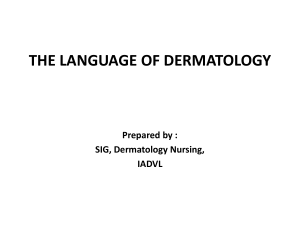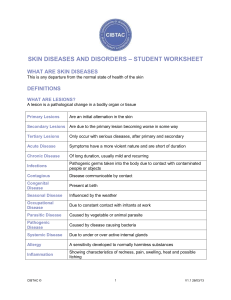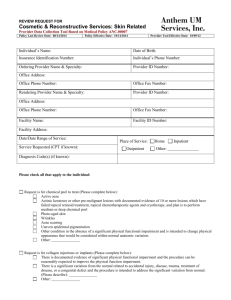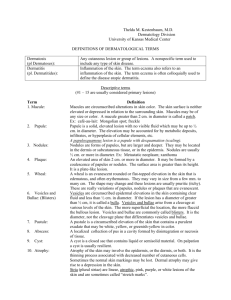Assessing and Managing Commonly Encountered Rashes and Lesions
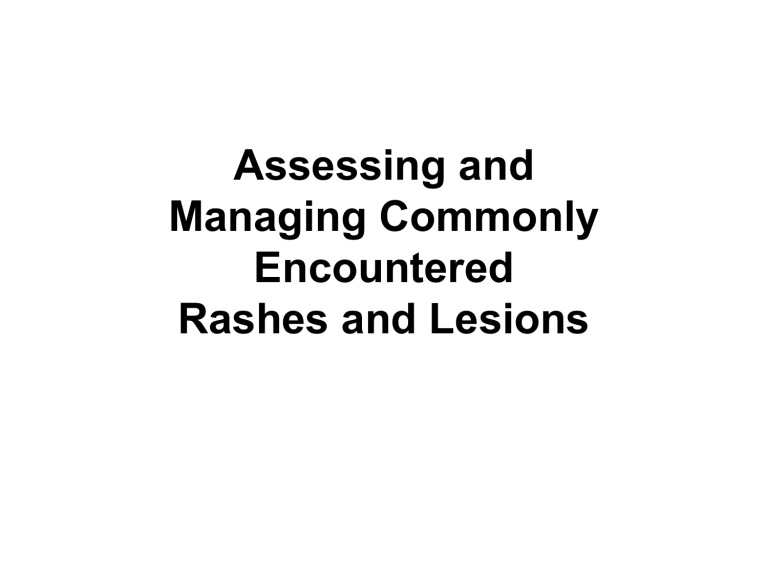
Assessing and
Managing Commonly
Encountered
Rashes and Lesions
HISTORY
• How long has the lesion been present?
• How did it look when it first appeared, and how is it now different?
• Where did it first appear?
• What associated symptoms, such as itching or pain, are associated with the lesion?
• Are any other family members affected or have a similar history?
• Has the patient ever had this rash or lesion before?
• What does the patient think caused the rash or lesion?
• Is anything new or different (eg, medications, personal care products, occupational or recreational exposures)?
PHYSICAL EXAMINATION
• Type of lesion
• Morphology of individual lesions
• Configuration of multiple lesions (eg, scattered, grouped, linear..)
• Distribution of lesions
• Color
• Consistency and feel
Can you describe this rash?
MORPHOLOGY
• Macules are nonpalpable lesions ≤1 cm that vary in pigmentation from the surrounding skin.
• Patches are nonpalpable lesions >1 cm. There are no elevations or depressions.
• Papules are palpable, discrete lesions measuring ≤5 mm in diameter .
• Plaques are large (>5 mm) superficial slightly raised lesions, often formed by a confluence of papules.
• Nodules are palpable, discrete lesions measuring ≥5 mm in diameter
• Tumors are large nodules.
MORPHOLOGY
• Telangiectasia is a dilated superficial blood vessel
• Purpura are red-purple lesions that do not blanch under pressure Purpuric lesions can be macular or raised
(palpable purpura)
• Pustules are small, circumscribed skin papules containing purulent material
• Vesicles are small (<5 mm diameter), circumscribed skin papules containing serous material
• Bullae are large (≥6 mm) vesicles.
• Wheals are irregularly elevated edematous skin areas that are often erythematous
Red scaly spots
70-year-old retired college professor
Notes multiple rough red scaly spots on forehead over past few years
Unresponsive to triamcinolone cream
These lesions most likely represent:
1. Actinic keratoses
2. Basal cell carcinomas
3. Seborrheic keratoses
4. Seborrheic dermatitis
5. Psoriasis
Actinic Keratoses
• These scaly sometimes red small patches and rough papules are considered precursors to squamous cell carcinoma
• Basal cell carcinomas are usually pearly papules
• Seborrheic dermatitis may involve the hairline but not usually the mid forehead, and will often respond to hydrocortisone
• Lesions of psoriasis are usually more distinct and the face is often spared in adults
• Treatments for actinic keratoses including topical agents (5-fluoruracil, imiquimod, diclofenac), cryotherapy, etc
Rashes you need to know
17-year-old male presented with skin rash and low-grade fever with intense pruritus:
This patient presented with - lesions that appear as papules, about 2 to 6 millimeters in diameter
Patient presented with complaints of a solitary, lesion that enlarged over several days.
Over the next several weeks, a generalized exanthem developed with mild to moderate pruritus.
What is the cause of this pruritic dermatologic manifestation?
Describe the patient at risk for developing this condition?
Cauliflower-like lesion
55-year-old police officer
Patient’s wife notices lesion on upper back enlarging progressively over last few years
The most likely diagnosis of this lesion is:
1. Actinic keratosis
2. Basal cell carcinoma
3. Keratoacanthoma
4. Seborrheic keratosis
5. Squamous cell carcinoma
• The lesion is a seborrheic keratosis, which often have a walnut- or cauliflower-like surface
• They are common in middle aged and elderly patients
• Actinic keratoses and squamous cell carcinomas are crusted plaques or papules, usually in sun-damaged skin
• Basal cell carcinoma is a pearly papule
Enlarging red crusted patch/plaque on the face
73-year-old retired secretary, selfconfessed “sun worshiper” with lesion on arm
Worse over last 6 months
Occasional bleeding
Different than many other “barnacles” he’s had treated in the past
Changing mole
63-year-old house painter with changing mole
Was present for “several years”, but seems to be changing more over last 6 months
What is the appropriate next step?
1. Have patient return in 6 months to recheck mole
2. Refer to oncologist
3. Perform shave biopsy
4. Perform punch biopsy
5. Refer to dermatologic surgeon
Worsening acne
22-year-old law student
Acne reappeared after 5-year hiatus
Which is the least likely cause of her flaring acne?
1. Isoniazid for positive PPD
2. Lithium citrate for bipolar disorder
3. Stress of law school exams
4. Zolpidem for sleep disturbance
5. Polycystic ovarian syndrome
Acne
• Isoniazid, lithium chloride, stress from exams all associated with new onset acne eruptions or exacerbation of acne
• Zolpidem not reported to affect acne
• Acne may be a presenting sign of polycystic ovarian syndrome
Petechiae surrounding the hair follicles on the legs in association with bleeding gums is a sign of
1. Vitamin B6 deficiency
2. Vitamin C deficiency
3. Drug reaction
4. Vitamin A deficiency
Scurvy
• The patient has the findings of vitamin C deficiency: bleeding gums and petechia surrounding the hair follicles especially on the legs
• The hairs may be twisted (“corkscrew hairs”)
• Zinc deficiency is associated with a periorificial and acral psoriasiform and desquamating eruption
• Gluten sensitive enteropathy is associated with the blistering eruption, dermatitis herpetiformis
• Vitamin B12 deficiency is associated with pernicious anemia
Solitary lesion on lip
58-year-old attorney notes lesion on lip for 2 days preceded by tingling.
Recently returned from ski trip
What is the most likely diagnosis?
1. Staphylococcal impetigo
2. Tinea faciei
3. Primary herpetic gingivostomatitis
4. Pemphigus vulgaris
5. Herpes labialis
Herpes labialis
• Herpes labialis is very common and can be recurrent
• Primary herpetic gingivostomatitis usually seen in younger patient, often associated with multiple lesions, extensive oral involvement
• Often provoked by UV exposure, infection, or other physiologic or other stressor
• Tinea would not present as lip vesicles
38-year-old male physician, 8-year history of multiple sclerosis, currently not on treatment. Lesions present for several months, growing
What is the most likely diagnosis?
1. Molluscum
2. Secondary syphilis
3. Filiform warts
4. Actinic keratoses
5. Seborrheic keratoses
Filiform warts
• Warts on face, especially nostrils, eye lids or corners of mouth, often show finger-like
(filiform) projections
• Molluscum are dome shaped
• Syphilis lesions typically moister, non-filiform, bilateral
• Wrong location for actinic/seborrheic keratoses
• Treatment includes cryotherapy, curettage, etc.
Multiple facial papules
46-year-old physician, history of bilateral facial papules for many years. No improvement with topical salicylic acid or tretinoin
What is your diagnosis?
1. Molluscum
2. Dermatosis papulosa nigra
3. Flat warts
4. Adenoma sebaceum
5. Nevoid basal cell carcinoma syndrome
Dermatosis papulosa nigra
• Share histopathology with seborrheic keratoses
• Often inherited as a dominant trait
• Malar location
• More raised than flat warts, not centrofacial like adenoma sebaceum
Worsening facial rash
28-year-old day care worker, facial rash worsening over last 12 weeks
Past medical history: migraines as teenager
Applied hydrocortisone cream for 4 days with no improvement
What is the most appropriate next step?
1. Terbinafine cream
2. Mupirocin ointment
3. Punch biopsy
4. Nystatin cream
5. Scraping for fungal culture
Tinea faciei
• The patient has tinea faciei, a superficial infection caused by dermatophytes like Trichophyton tonsurans
• Terbinafine is effective against most dermatophytes; nystatin is effective only against yeasts like Candida
• While topical therapy may work, widespread or longstanding cases may require oral antifungal therapy
• Best to establish diagnosis before instituting oral antifungal therapy
Itchy rash
40-year-old waiter, Itchy rash behind knees appeared over last few weeks. Similar lesions in antecubital fossae. Has had problem off and on all of his life. Worse when he was a child, now more restricted in distribution
Which is the most likely diagnosis?
1. Atopic dermatitis
2. Psoriasis
3. Seborrheic dermatitis
4. Allergic contact dermatitis
5. Tinea corporis
Atopic dermatitis
• Typical distribution in antecubital and popliteal fossae, neck
• Itching is chief symptom
• May resolve over time or persist into adulthood
Which organism is most likely to be cultured from these lesions?
1. Streptococcus pyogenes
2. Streptococcus pneumoniae
3. Staphylococcus epidermidis
4. Staphylococcus aureus
Culture results
• The correct answer is “Staphylococcus aureus.
” S aureus can be cultured from active lesions of atopic dermatitis in
> 75% of patients
Which is the most appropriate topical treatment for this eruption?
1. Corticosteroid
2. Mupirocin
3. Retapamulin
4. Pimecrolimus
5. Tretinoin
Answer
• The correct answer is topical corticosteroid
• Even if staphylococcus is present, studies show that treatment with a topical corticosteroid will reduce bacterial counts
• Use of a topical antimicrobial such as mupirocin or retapamulin will not treat underlying atopic dermatitis
• Pimecrolimus, a calcineurin inhibitor, is indicated as second line therapy for atopic dermatitis in patients in whom a conventional therapy is ineffective or would be inappropriate
Targetoid rash after URI
24-year-old college student
Upper respiratory infection 10 days ago
Treated with amoxicillin/clavulanic acid
Rash appeared 6 days into therapy
What is your diagnosis?
1. Fixed-drug eruption
2. Erythema multiforme
3. Henoch-Schoenlein purpura
4. Urticaria
5. Tinea corporis
40-year-old female.
Upper respiratory infection 10 days ago
Treated with amoxicillin/clavulanic acid
Sores in mouth for 3 days, painful
What is your diagnosis?
1. Erythema multiforme
2. Pemphigus vulgaris
3. Urticaria
4. Urticaria pigmentosa
5. Dermatomyositis
Erythema multiforme
• Correct answer is erythema multiforme
• Erosive mucositis combined with fixed, painful,target-like lesions with necrotic centers
• Pemphigus vulgaris is not associated with target-like lesions
• Urticaria is migratory and lacks mucositis
• Lesions of urticaria pigmentosa are brown oval macules and plaques and do not appear suddenly
Single target
30-year-old attorney
Returns from camping trip in upstate New York
Target-like lesion on arm
Fever, malaise
Camping trip redux
22-year-old male returns from a winter camping trip in Upstate New York
3-day history of itchy and painful lesions
Previously healthy
What is the most likely diagnosis?
1. Rhus (poison ivy) dermatitis
2. Lyme borreliosis
3. Contact dermatitis to backpack
4. Herpes zoster
5. Bed bug bites
What is the most likely diagnosis?
1.Eczema
2.Herpes zoster
3.Tinea corporis
4.Psoriasis
Which could be the cause of her worsening psoriasis?
1. Bronchitis treated with azithromycin
2. Hepatitis A infection
3. Fluconazole for vaginal candida
4. Initiation of beta-blocker for hypertension
5. Initiation of atorvastatin for hypercholesterolemia
What is the most appropriate next step?
1. Initiate treatment with topical corticosteroid
2. Prescribe a short course of prednisone
3. Prescribe a week of oral amoxicillin
4. Recommend daily use of tanning booth
5. Refer to dermatologist
Next step
• The next step is to refer to dermatologist
• Severe extensive psoriasis is unlikely to show acceptable response to even potent corticosteroids
• Prednisone can be associated with severe rebound flares of psoriasis or conversion to pustular form; moreover it is not an appropriate solution for a chronic condition
• Dermatologist may choose to treat patient with ultraviolet B light, systemic TNF-alpha-blocker or oral agent (eg, methotrexate)
Extensive hair loss
23-year-old medical student
Rapid loss of hair within 2 weeks of starting first clinical rotation
Which is the most likely diagnosis?
1. Hypothyroidism
2. Telogen effluvium
3. Alopecia areata
4. Discoid lupus
5. Trichotillomania
Eruption on face and hands
38-year-old pastry chef
Notes history of facial rash that waxes and wanes, sometimes present on hands
Recently diagnosed with “fibromyalgia”
What test do you think is most likely to be abnormal?
1. Patch testing for allergic contact dermatitis
2. Anti-thyroid microsomal antibodies
3. Creatine phosphokinase
4. Glucose-6-phosphate dehydrogenase
5. Total iron binding capacity
Dermatomyositis
• This woman has the heliotrope rash of dermatomyositis
• Rash is often photo-exacerbated
• Elevation of muscle enzymes (creatine phosphokinase, aldolase) are typical due to the myositis
• In adults, dermatomyositis may occur in association with a variety of malignant neoplasms
Facial hair/pigmentation
42-year-old HIV-positive nurse
On highly active anti-retroviral therapy
Over past year, notes facial hyperpigmentation and increased facial hair
Also complains of new onset hand rash
Porphyria cutanea tarda
• Can be associated with ethanol, estrogen, hepatitis and HIV
• Phototoxic and photoallergic eruptions do not generally manifest with temporal/cheek hypertrichosis and hyperpigmentation
• Elevated urine porphyrins
• Treatment with phlebotomy
“Dirty neck”
38-yearold office worker complains of “dirty neck” that won’t wash off
Past medical history: unremarkable
Which test is most likely to be abnormal?
1. Thyroid stimulating hormone
2. Chest X-ray
3. Stool guaiac
4. HbA1C
5. Serum prolactin
Acanthosis nigricans
• Acanthosis nigricans is a brown velvety thickening of the skin on the neck and body folds, especially the axillae
• It is most commonly associated with abnormal glucose tolerance and obesity
New onset face and hand lesions
55-year-old saxophonist
New onset eruption
Denies fever or other systemic symptoms
Lesions asymptomatic
Hypertension well-controlled on enalapril
What blood test will you order?
1. ANA
2. EBV serology
3. Hepatitis screen
4. Scl-70
5. VDRL
Secondary syphilis
• Diagnosis of secondary syphilis made by
VDRL
• EBV can be associated with a morbilliform eruption upon exposure to ampicillin or related drugs
• Hepatitis rarely associated with lichenplanus like eruptions
• Scl-70 and ANA used to diagnose scleroderma and lupus; findings generally do not resemble these
Soft bumps
30-year-old man sent for pre-employment physical
More than 30 soft bumps on arms, trunk, and face
Multiple flat, brown spots on trunk
Bowed shins
Hypertension
Seen by audiologist; bilateral hearing normal
The most likely diagnosis is:
1. Tuberous sclerosis
2. Cowden syndrome
3. Nevus sebaceus of Jadassohn
4. Neurofibromatosis Type 1
5. Neurofibromatosis Type 2
Next Generation
Which of the following is least likely to be positive in a 10-year-old child with NF-1?
1. Skin examination for café-au-lait macules
2. Skin examination for neurofibromas
3. Ocular examination for Lisch nodules
4. Skin examination for axillary freckling
Facial pigmentation
76-year-old retired auto worker
Worsening blue-gray facial pigmentation over last year
Which medications can be associated with this problem?
1. Albuterol
2. Amiodarone
3. Cromolyn sodium
4. Bortezomib
5. Montelukast
